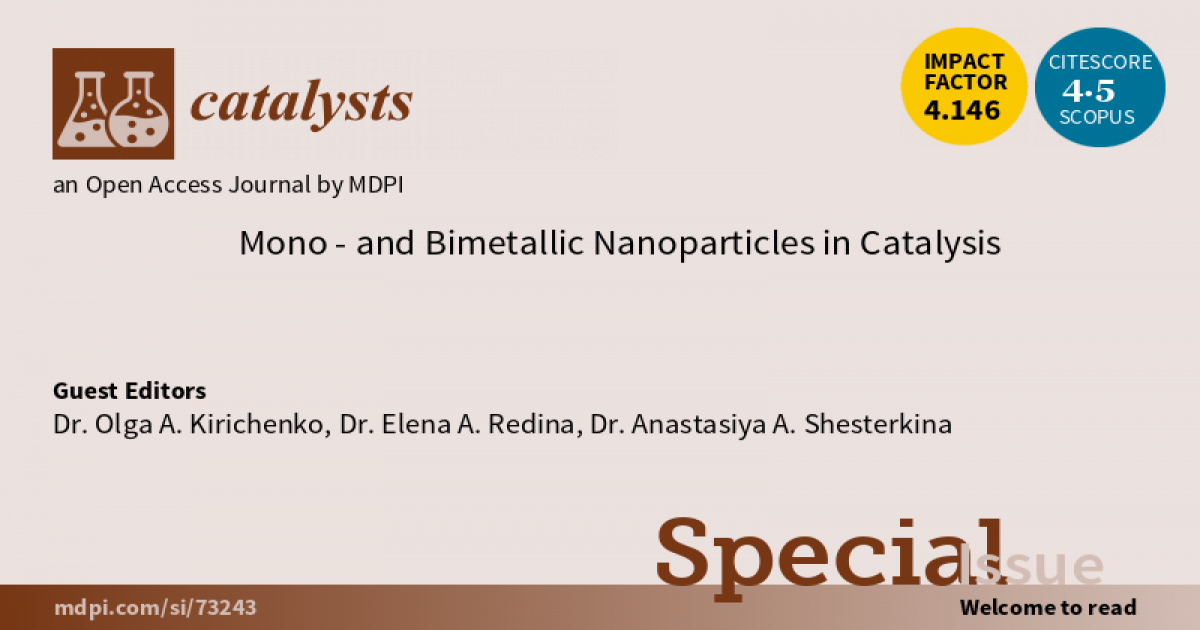Mono- and Bimetallic Nanoparticles in Catalysis
A special issue of Catalysts (ISSN 2073-4344). This special issue belongs to the section "Nanostructured Catalysts".
Deadline for manuscript submissions: closed (31 July 2022) | Viewed by 20557

Special Issue Editors
Interests: heterogeneous catalysis; scientific basics for the catalyst preparation; catalyst design and engineering; inorganic materials; nanocatalysts and nanomaterials
Interests: catalysis in organic synthesis; green chemistry; catalyst synthesis and development; bimetallic catalysts; selective oxidation; selective hydrogenation; catalysis by gold
Interests: selective hydrogenation; bimetallic nanoparticles; heterogeneous Fe-containing catalysts; catalysis in organic synthesis; green chemistry; catalyst synthesis and development
Special Issue Information
Dear Colleagues,
Catalysts based on mono- and bimetallic nanoparticles have been used at laboratory, pilot-plant, and industrial scale for several years. Nevertheless, they are still of considerable interest due to the discovery of the new compositions and structures bearing unknown and unique catalytic properties. Other reasons include changes in major trends in chemical engineering, process safety, and cost, as well as the appearance of new renewable raw materials and the need for novel up-to-date chemical products.
This Special Issue will provide information on recent advances in the synthesis of mono- and bimetallic nanoparticles for applications in the catalytic processes, as well as studies on the structure of nanoparticles and their catalytic behavior. We welcome papers focusing on novel synthesis methods of metallic nanoparticles for the diverse applications in catalysis, especially in novel promising reactions and processes. Variations in procedures of known methods that result in strong improvement of the catalytic properties are of interest as well. Studies of the systems “no noble metal – support” and “noble metal – no noble metal – support”, as well as the use of metal oxide combinations as supports or supported phases, are of particular interest. We encourage the submission of all types of papers, including communications, research, and review papers, that cover all topics of innovative catalytic applications of mono- and bi-metallic nanoparticles.
Dr. Olga A. Kirichenko
Dr. Elena A. Redina
Dr. Anastasiya A. Shesterkina
Guest Editors
Manuscript Submission Information
Manuscripts should be submitted online at www.mdpi.com by registering and logging in to this website. Once you are registered, click here to go to the submission form. Manuscripts can be submitted until the deadline. All submissions that pass pre-check are peer-reviewed. Accepted papers will be published continuously in the journal (as soon as accepted) and will be listed together on the special issue website. Research articles, review articles as well as short communications are invited. For planned papers, a title and short abstract (about 100 words) can be sent to the Editorial Office for announcement on this website.
Submitted manuscripts should not have been published previously, nor be under consideration for publication elsewhere (except conference proceedings papers). All manuscripts are thoroughly refereed through a single-blind peer-review process. A guide for authors and other relevant information for submission of manuscripts is available on the Instructions for Authors page. Catalysts is an international peer-reviewed open access monthly journal published by MDPI.
Please visit the Instructions for Authors page before submitting a manuscript. The Article Processing Charge (APC) for publication in this open access journal is 2200 CHF (Swiss Francs). Submitted papers should be well formatted and use good English. Authors may use MDPI's English editing service prior to publication or during author revisions.
Keywords
- Synthesis of metallic nanoparticles
- Supported nanocatalysts
- Preparation of nanocatalysts
- Design of bimetallic nanoparticles
- Stabilization of metallic nanoparticles
- Selective hydrogenation
- Selective oxidation
- Large scale products
- Green chemistry
- Heterogeneous catalysis in organic synthesis
Benefits of Publishing in a Special Issue
- Ease of navigation: Grouping papers by topic helps scholars navigate broad scope journals more efficiently.
- Greater discoverability: Special Issues support the reach and impact of scientific research. Articles in Special Issues are more discoverable and cited more frequently.
- Expansion of research network: Special Issues facilitate connections among authors, fostering scientific collaborations.
- External promotion: Articles in Special Issues are often promoted through the journal's social media, increasing their visibility.
- Reprint: MDPI Books provides the opportunity to republish successful Special Issues in book format, both online and in print.
Further information on MDPI's Special Issue policies can be found here.







